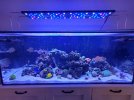I have been battling dinos for the last several weeks. I have been able to manage them slightly but nothing seems to knock them out or down to acceptable levels. So far have tried in various combinations reduced photoperiods, blackouts, bacteria dosing, constant filter sock changing, blowing off rocks, not blowing off rocks, ph elevation...I have never had 0 nutrients (always have kept about .1 phosphate and 2-4 nitrate) so I didn't really want to try raising them artificially any further as some suggest. Definitely a prime example of how you don't have to be reading zeros in your nutrients to get bit by dinos.
I microscope confirmed them as the Ostreopsis variety, which the community at large has found success using UV to combat. Finally broke down and invested in a UV. I have it temporarily ran to my main display until I can find a good sump mounting solution. As you can see in my picture, I couldn't find the duct dape lol
Funny, my Acropora have been taking off during all this. Its my soft corals that are upset. I think its because the dino snot sticks to their polyps much more and don't blow off easily. I have a gorgonian that hasn't really opened up in probably two weeks save a few random polyps here or there.
I microscope confirmed them as the Ostreopsis variety, which the community at large has found success using UV to combat. Finally broke down and invested in a UV. I have it temporarily ran to my main display until I can find a good sump mounting solution. As you can see in my picture, I couldn't find the duct dape lol
Funny, my Acropora have been taking off during all this. Its my soft corals that are upset. I think its because the dino snot sticks to their polyps much more and don't blow off easily. I have a gorgonian that hasn't really opened up in probably two weeks save a few random polyps here or there.





